Region-specific and calcium-dependent increase in dialysate choline levels by NMDA
- PMID: 9570791
- PMCID: PMC6793164
- DOI: 10.1523/JNEUROSCI.18-10-03597.1998
Region-specific and calcium-dependent increase in dialysate choline levels by NMDA
Abstract
NMDA receptor-induced excitotoxicity has been hypothesized to mediate abnormal choline (Cho) metabolism that is involved in alterations in membrane permeability and cell death in certain neurodegenerative disorders. To determine whether NMDA receptor overactivation modulates choline metabolism in vivo, we investigated the effects of NMDA on interstitial choline concentrations using microdialysis. Perfusion of NMDA by retrodialysis increased dialysate choline (approximately 400%) and reduced dialysate acetylcholine (Ach) (approximately 40%). Choline levels remained increased for at least 2.5 hr, but acetylcholine returned to pretreatment values 75 min after NMDA perfusion. The NMDA-evoked increase in dialysate choline was calcium and concentration dependent and was prevented with 1 mM AP-5, a competitive NMDA antagonist, but was not altered by mepacrine, a phospholipase A2 inhibitor. NMDA increased extracellular choline levels four- to fivefold in prefrontal cortex and hippocampus, produced a slight increase in neostriatum, and did not modify dialysate choline in cerebellum. Perfusion with NMDA for 2 hr produced a delayed, but not acute, reduction in choline acetyltransferase activity in the area surrounding the dialysis probe. Consistent with a lack of acute cholinergic neurotoxicity evoked by this treatment, basal acetylcholine levels were unaltered by 2 hr of continuous NMDA perfusion. Prolonged NMDA perfusion produced a 34% decrease in phosphatidylcholine content in the lipid fraction of the tissue surrounding the dialysis probe. These results show that NMDA modulates choline metabolism, eliciting a receptor-mediated, calcium-dependent, and region-specific increase in extracellular choline from membrane phospholipids that is not mediated by phospholipase A2 and precedes delayed excitotoxic neuronal cell death.
Figures
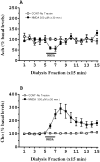
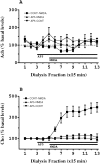



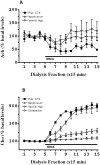


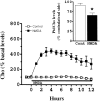
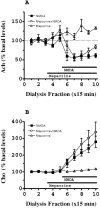
References
-
- Bazan NG, Rodriguez de Turco EB, Allan G. Mediators of injury in neurotrauma: intracellular signal transduction and gene expression. J Neurotrauma. 1995;12:791–814. - PubMed
-
- Benveniste H, Hansen AJ, Ottosen NS. Determination of brain interstitial concentrations by microdialysis. J Neurochem. 1989;52:1741–1750. - PubMed
-
- Bierer LM, Haroutunian V, Gabriel S, Knott PJ, Carlin LS, Purohit DP, Perl DP, Schmeidler J, Kanof P, Davis KL. Neurochemical correlates of dementia severity in Alzheimer’s disease: relative importance of the cholinergic deficits. J Neurochem. 1995;64:749–760. - PubMed
-
- Bogdanov MB, Wurtman RJ. Possible involvement of nitric oxide in NMDA-induced glutamate release in the rat striatum: an in vivo microdialysis study. Neurosci Lett. 1997;221:197–201. - PubMed
-
- Choi DW. Glutamate receptors and the induction of excitotoxic neuronal death. In: Bloom F, editor. Neuroscience: from the molecular to the cognitive. Elsevier; Amsterdam: 1994. pp. 47–51. - PubMed
Publication types
MeSH terms
Substances
LinkOut - more resources
Full Text Sources
